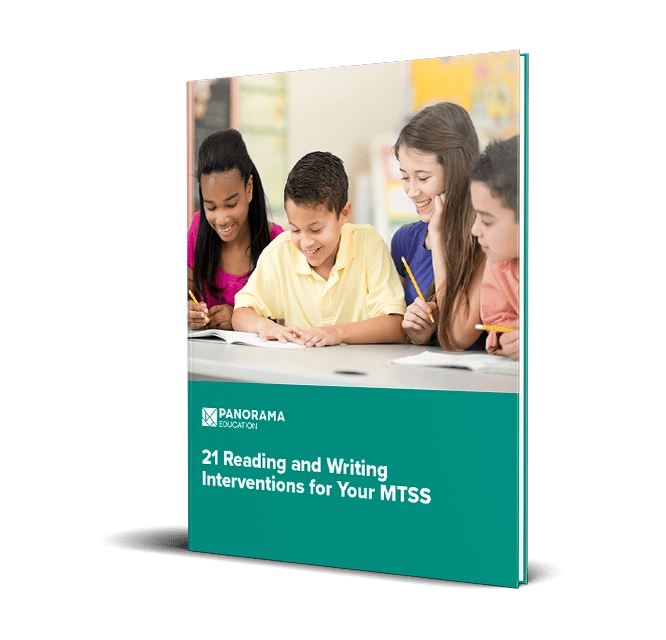Reading performance is often seen as a key indicator of overall district success—and for good reason. Like writing, reading is a critical skill that influences academic achievement across all subject areas, not just ELA. Students who are behind in reading can struggle to keep up with cross-curricular demands in history, science, and many other subjects.
But the data tells a grim story of reading performance across the country: two-thirds of fourth graders and eighth graders cannot read proficiently. And literacy scores have only been declining in recent decades.
Fortunately this data has sparked a bigger focus on improving literacy instruction, most notably with science of reading legislation. These laws emphasize the use of science-backed reading practices proven to enhance literacy outcomes. By supporting students with research- and evidence-based reading interventions, schools aim to ensure that every reader has the tools they need to succeed.
In this guide, you'll find six research-based reading interventions and strategies to implement effective practices for building reading skills in your district.
Download 21 ELA interventions to share with your school and district teams
Table of Contents:
Understanding Reading Intervention in MTSS/RTI
Tier 1: Universal Reading Interventions
Tier 2: Targeted Reading Interventions
Tier 3: Intensive Reading Interventions
Next Steps for District Leaders
Understanding Reading Intervention in MTSS/RTI
Districts using a multi-tiered system of supports (MTSS) or Response to Intervention (RTI) model rely on high-quality, research-based interventions to meet the needs of all students. A key tenet of an RTI/MTSS framework is identifying students in need of support and providing them with targeted interventions. The goal of reading intervention is to improve student outcomes so that every student has a chance to meet academic goals.
A strong RTI/MTSS starts with a foundation of effective universal Tier 1 strategies administered to all students to ensure they receive high-quality instruction. Students who need additional support are given targeted Tier 2 interventions. To address any skill gaps, few students receive individualized, intensive interventions at Tier 3.

Reading Intervention and the Science of Reading
Research and evidence is an integral part of the body of research known as the science of reading (SoR). Literacy laws passed in response to the SoR movement include a focus on using methods proven to work. Many states now require any reading interventions to be evidence-based or research-based, meaning the strategy has research studies that prove its effectiveness, or it is based on a solid foundation of research. This requirement is designed to maximize the chance that a reading intervention will improve student outcomes.
The reading interventions in this blog have been selected from Playbook, Panorama’s professional learning library for K-12 educators. Districts and schools that partner with Panorama have full access to a collection of nearly 900 strategies, instructional resources, and MTSS interventions developed by our subject matter experts and curriculum partners.
Tier 1: Universal Reading Interventions
Tier 1 reading interventions are administered to all students to establish a solid foundation of literacy instruction. Ideally, 80% of students should respond proficiently to Tier 1 instruction.
Story Comparing
This activity engages students in comparing and contrasting the narrative structures of two different texts. Students will identify and discuss story elements, allowing them to understand how different authors build stories, deepening comprehension skills.
Focus Area: Comprehension
Developmental Stage: Lower Elementary
Preparation:
- Choose two narrative texts that are age-appropriate and have similar themes, characters, or settings but different plot development.
- Prepare graphic organizers that include spaces for the title, author, and specific story elements like characters, setting, problem, solution, etc., along with areas for marking similarities and differences. Click here to download a copy of our templates.
- Write questions or prompts that guide students in discussing story elements.
Instructions:
- Arrange the selected texts at the center of the table or reading area, and provide each student with a student sheet.
- Students select one of the two texts and read it. They then write the story title and author of the text on the graphic organizer in the designated areas.
- As a group or in pairs, students discuss the story elements of each story, using prepared questions or prompts. They decide which elements are unique to each story and which are the same.
- Students record their findings under the corresponding story title or shared area on the student sheet.
- Repeat steps 2-4 with the second text, continuing until all story elements are discussed and recorded.
- The teacher reviews the student sheets, evaluating understanding and offering feedback. This could include a class discussion to summarize findings.
4A’s Text Protocol
This activity encourages students to both listen deeply to others' opinions about a text as well as share their own thoughts.
Focus Area: Comprehension
Developmental Stage: Middle School, High School
Preparation:
- Select an age-appropriate text for the group to read.
- Gather materials: highlighter, pen/pencil, sticky notes.
Instructions:
- Share the text with the group and ask participants to read it silently.
- Prompt students to highlight the text and write notes in the margin or on sticky notes to answer these four questions:
- What assumptions does the author of the text hold?
- What do you agree with in the text?
- What do you want to argue with the text?
- What parts of the text do you want to aspire to (or act upon)?
- Split the class into groups of four. Explain that individuals in each group will be taking turns sharing some of their notes. Explain that each round will be four minutes long and that groups should identify a timekeeper (who will still participate).
- The first round begins with a volunteer taking one minute to share an assumption in the text, citing the text (with page numbers, if included) as evidence. The volunteer will briefly talk about why they selected this passage.
- Other participants should be actively listening but not responding. If they would like to comment on something, they can jot it down and do so later on.
- After one minute, switch to the next person in the group, who will have one minute to do the same.
- Rotate so that each member of the group shares their assumption and rationale for selection.
- Repeat, starting with a new student to share another “A” from the text (e.g., agree, argue, aspire).
- After a group has finished moving through each “A”, open up the discussion for students to share thoughts and takeaways that they heard while listening.
- Finish by debriefing the activity with the full class. What important points came out of each group's discussion? How did you feel while using this protocol?
Tier 2: Targeted Reading Interventions
Tier 2 reading interventions involve targeted small-group instruction for those who need additional support after receiving Tier 1 instruction. Approximately 15 to 20% of students will need Tier 2 supports.
Reading PALS
When students explain to others, they deepen their understanding and gain confidence in their learning. This strategy is provided by Panorama’s curriculum partners at Digital Promise.
Focus Area: Vocabulary, Fluency, Comprehension
Developmental Stage: Lower Elementary, Upper Elementary, Middle School, High School
Instructions:
With Peer-Assisted Learning Strategies (PALS), students provide and receive immediate feedback from their peers, which can increase their reading fluency, vocabulary development, and comprehension.
Example: Use This Strategy In Your Classroom (High School)
Watch how this ninth grade teacher uses reciprocal teaching with the roles of summarizer, questioner, clarifier, and predictor in her language arts classroom. By offering example questions, students are able to autonomously read and discuss in their small groups, deepening their comprehension and social and relationship skills.
Example: Use This Strategy In Your Classroom (Upper Elementary School)
Watch two upper elementary school students practice part of a prediction relay. By stopping halfway through the page, students have the opportunity to make predictions, check the accuracy of their predictions, and switch roles. Using this structure requires both students to maintain their attention and practice Inhibition & self-regulation while listening.
Phoneme Pathfinders
In this engaging activity, students use a card game to explore and match medial phonemes, fostering their phonological awareness and recognition of sounds within words.
Focus Area: Phonemic Awareness
Developmental Stage: Lower Elementary
Preparation:
- Gather materials: phoneme matching cards with corresponding images (e.g., cat, bat, mat), card holders or mats for placing the cards, a timer, and printed instructions for the game.
- Prepare the matching cards beforehand, making sure to include multiple examples of each medial phoneme. Set up the playing area with mats or cardholders.
Instructions:
Introduction (5 min):
- Explain the importance of phonemes in words and introduce medial phonemes.
- Demonstrate how to play the game by showing the matching process using one set of cards.
Playing the Game (25 min):
- Place medial phoneme picture cards face down in a stack at the center.
- Students select five cards each off the top of the stack and check their cards for pairs of pictures that have the same medial sound.
- Taking turns, students read matches and state the medial sound. For example, “I have heart and barn. The medial sound is /ar/.” Place the matched pairs down on the table.
- Select one card from the deck. Look at the cards in their hands to try to make a match.
- If a match is made, say the names and the medial sounds of the pictures and place with other matched cards on the table.
- If no match is made, the next student takes a turn.
- Continue until all pairs are made.
- Students provide feedback to one another on the correct identification of medial sounds and the understanding of the game's rules.
Tier 3: Intensive Reading Interventions
Some students may need one-on-one instruction and highly individualized support after receiving Tier 1 and Tier 2 strategies. Tier 3 reading interventions address specific skill gaps for about 1 to 5% of students.
Story Mapping
Story Mapping is a strategy where students create a graphic organizer to visualize the elements and structure of a story. It helps students understand the text on a structural level, which builds literary analysis and writing skills. It is applicable as an individual or group exercise, and is equally effective as a learning strategy, as well as an assessment tool.
Focus Area: Comprehension, Writing
Developmental Stage: Lower Elementary, Upper Elementary, Middle School, High School
Preparation:
- Prepare a blank story map for each student. To make a copy for elementary students, click here. To make a copy for secondary students, click here.
- To use the story map, students must be familiar with the elements of a story: character, plot, setting, and theme.
- The terminology for various story elements may be scaffolded, or adapted for younger grades, such as:
- Character, Setting, Actions, Problem, Solution
- Character, Setting, Events, Ideas
- Who, Where, What happens, Why
Instructions:
- Remind students of the elements of a story.
- Provide students with a blank story map template to fill in.
- Model the construction of a story map graphic organizer for a commonly-known story.
- As students read a new story, have them stop periodically to fill in parts of the story map.
- Give students time to compare their story maps and make necessary changes as they read.
3H Strategy
3H is a mnemonic learning strategy that students can use to remember how to answer different types of comprehension questions. It involves the three types of question-answer relationships: here, hidden, and in my head.
Focus Area: Comprehension
Developmental Stage: Lower Elementary, Upper Elementary, Middle School, High School
Preparation:
- Select reading passages
- Download the 3H poster
Instructions:
- Explain why students should learn this strategy. Using the 3H poster, explain each type of question.
- “Here” refers to answers that are found in the text directly “on the lines.” These answers are typically found in one place.
- “Hidden” refers to answers that are found “between the lines.” These answers can be found by joining together information that is found in different places in the text.
- “In My Head” refers to answers that are found “beyond the lines.” These answers come from background knowledge or may involve opinions or what a reader thinks.
- Give an example of each type of question from a current movie or fairy tale students are familiar with or use relevant examples from the school’s culture.
- Model the strategy: After explaining the strategy, proceed with modeling. Use a think aloud strategy, and voice out the thought process behind each stage.
- Instruct the students to write “Here,” “Hidden,” or “In My Head” next to each comprehension question. Repeat this activity with different passages and different comprehension questions. This may need to occur over the course of several days based on the needs of the students.
- Guided practice: Guide students in performing the strategy in small groups or in pairs. If students need additional support, they can orally recite the description of the three H’s or use notecards with a description written on them. Monitor student progress.
- During this time, scaffold the learning and support students who need assistance in using the strategy. They can also model the think aloud strategy (when in pairs) to strengthen comprehension and learning of the steps involved.
- Independent practice: After guided practice, students should only use the strategy independently, once they have shown they have mastered the strategy.
- Students can also be given the opportunity to reflect on the strategy.
 Educators can easily create and track reading intervention plans in Panorama Student Success, including setting SMART goals, attaching documents, and selecting progress monitoring methods.
Educators can easily create and track reading intervention plans in Panorama Student Success, including setting SMART goals, attaching documents, and selecting progress monitoring methods.
Next Steps for District Leaders
Implementing research-based interventions into your district’s reading curriculum is a proven way to impact student achievement. As you roll out new strategies, be sure to progress monitor and gather essential data throughout the implementation to determine if interventions are working as expected. Give the interventions time to take effect, but remember that educators can make adjustments to a student’s intervention plan if needed.
High-quality interventions will not only ensure that students get the support they need, but also that your district meets state requirements for effective instruction. As new literacy laws gain traction, district leaders should equip themselves with the tools and guidance necessary to elevate reading instruction and student outcomes.







